Uranium is a naturally occurring radioactive element, which has the atomic number of 92 and corresponds to the chemical symbol U in the periodic table. It belongs to a special group of elements called "actinides" - elements that were discovered relatively late in history. Like all other actinides, uranium is "radioactive" - it decays over time and releases energy in the process. Its special properties make uranium the main source of fuel for nuclear reactors - a chicken-egg sized amount of uranium fuel can provide as much electricity as 88 tonnes of coal.
Uranium is among the more common elements in the earth's crust - about 500 times more common than gold. Although it seems a very rare element, small amounts of uranium are present everywhere - in rock, soil, water, and even our bodies. There are also large amounts of highly diluted uranium in the ocean - approximately four billion tonnes.
Just like any other element, uranium comes in several variations that differ in mass and physical properties but share the same chemical properties. Those are called isotopes.
What are the different isotopes of uranium?
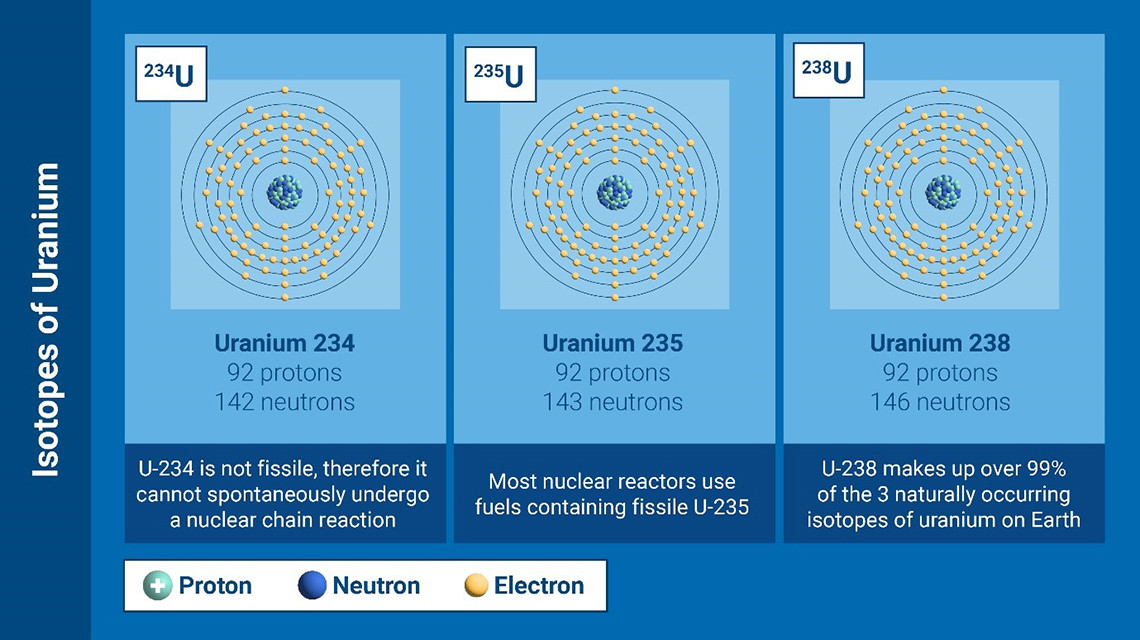
U-238 makes up over 99% of the 3 naturally occurring isotopes of uranium on Earth. (Infographic: A. Vargas/IAEA)
There are three natural isotopes of uranium - uranium-234 (U-234), uranium-235 (U-235) and uranium-238 (U-238). U-238 is the most common one, accounting for around 99 per cent of natural uranium found on earth. Most nuclear reactors use fuels containing U-235, however, natural uranium typically contains only 0.72 per cent of U-235 and, most reactors need a higher concentration of this isotope in their fuel. Therefore, the U-235 concentration is being artificially increased through a process called enrichment. Only the CANDU reactors from Canada are fuelled with non-enriched uranium.
What is uranium enrichment?
Uranium enrichment is the process, through which the isotopic proportion of U-235 is increased from 0.72 per cent to up to 94 per cent.
Uranium is considered low-enriched if its isotopic proportion of U-235 remains below 20 per cent. Most commercial reactors use low-enriched uranium (LEU) below five per cent as fuel, which is also often referred to as "reactor-grade uranium". LEU does not deteriorate and can be safely stored for many years.
If uranium is enriched beyond 20 per cent, it is considered highly enriched. Uranium with such high isotopic proportions of U-235 is mostly used in naval propulsion reactors (for example in submarines), nuclear weapons and some research reactors.
Different methods can be used to increase the isotopic proportion of U-235. Typically, the yellow cake is converted into a gaseous form, called uranium hexafluoride. This gas is then pumped into fast spinning cylinders - centrifuges - where heavier isotopes, such as U-238, are pushed towards the walls of the cylinders, and the lighter U-235 stays in the centre of the cylinders. This enables to "filter out" and collect the gas with higher concentrations of U-235. The process can be repeated until the isotopic proportion of U-235 is sufficient. The acquired gas then goes through a process of re-conversion, which enables it to turn U-235 into the form of black power - uranium dioxide.
How is uranium mined?
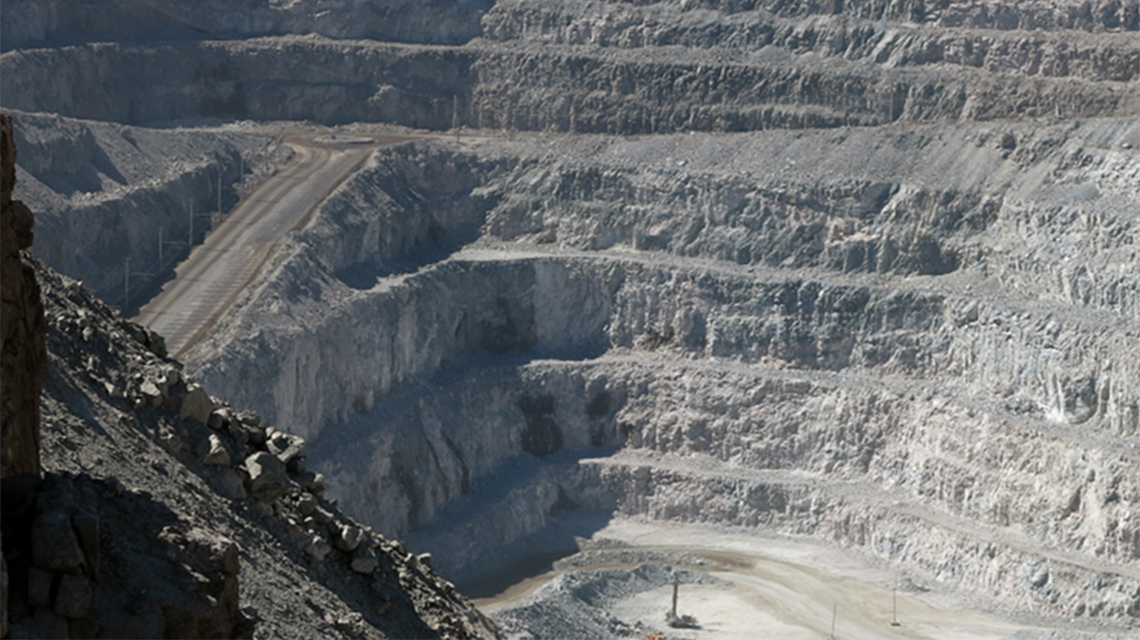
Rossing Uranium Mine, Namibia (Photo: C. Brady/IAEA)
In the 20th century, uranium ore was mostly mined from open pits or underground excavation sites, which required the ore to be crushed and refined to separate uranium from other elements.
In the 21st century this method has been gradually replaced by "in-situ leaching". While only 16 per cent of uranium were produced via this technique in 2000, in-situ leaching is currently the most common method of uranium mining. In 2020, around 58 per cent of uranium worldwide was mined using this method.
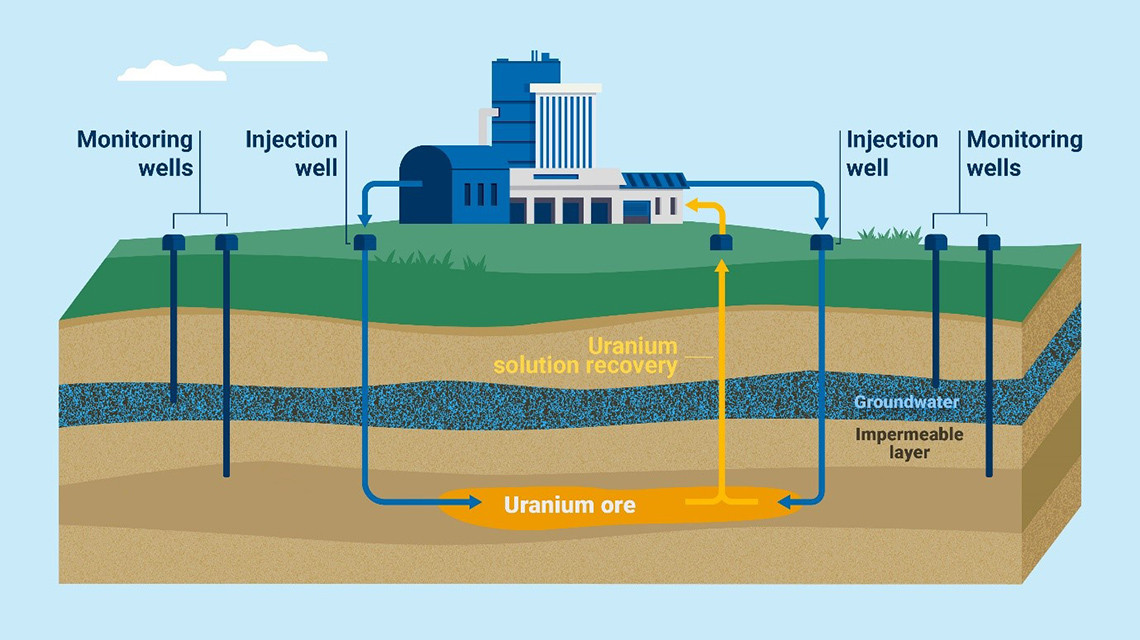
In situ leaching (Infographic: A. Vargas/IAEA)
In-situ leaching circulates water with additional elements, such as complexing or oxidant agents, or acids, through underground uranium deposits. This method allows to dissolve uranium directly out of the deposit. The resulting solution is then extracted from underground and refined to produce uranium oxide - or "yellowcake", which is used in uranium enrichment.
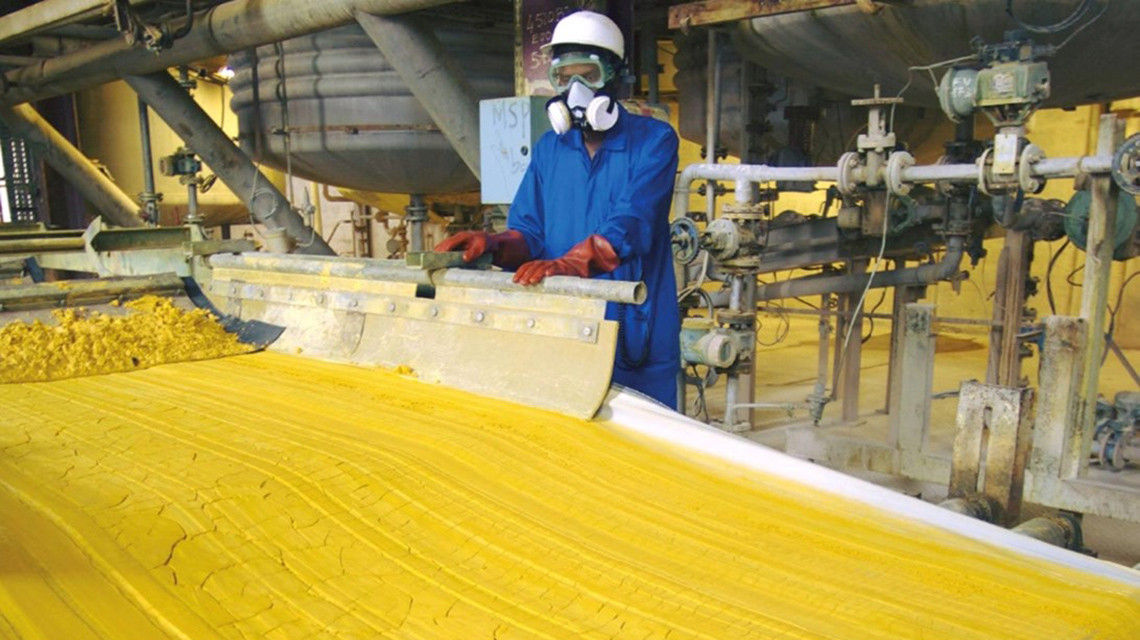
Yellowcake coming out of the filter press (Photo: Orano)
The stepwise processes of mining uranium, making it into nuclear fuel, irradiating the fuel in a nuclear power plant and disposing of the resulting waste is called the nuclear fuel cycle.
The Nuclear Fuel Cycle
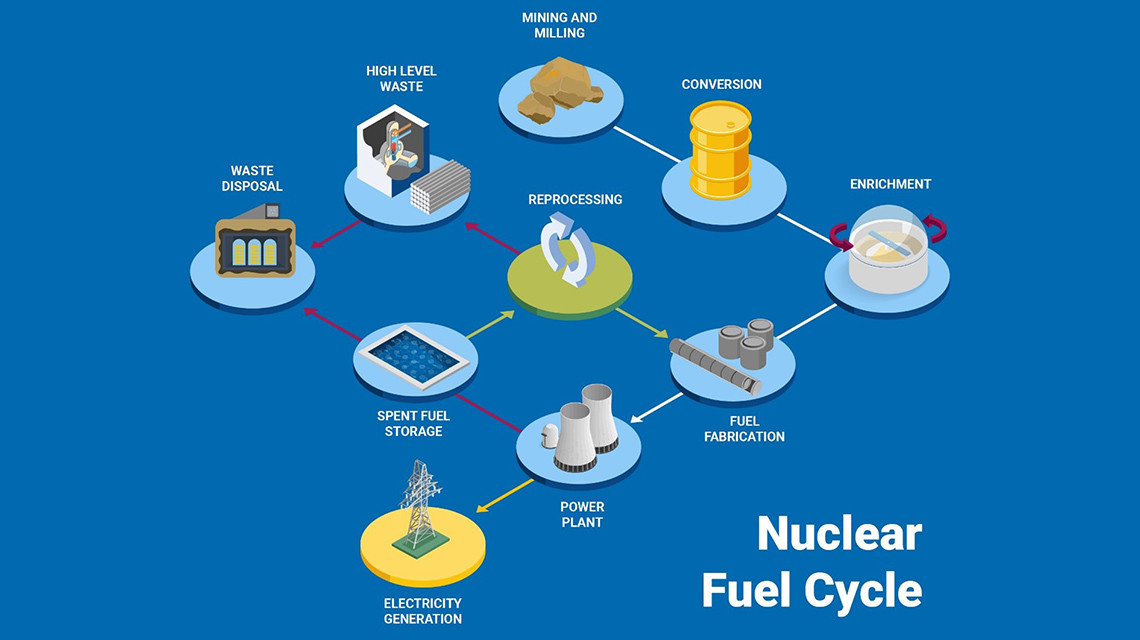
Spent fuel can also be reprocessed and reused. (Infographic: A. Vargas/IAEA)
The nuclear fuel cycle is an industrial process involving various activities to produce electricity from uranium in nuclear power reactors. Exploration for uranium is followed by mining and milling of the raw uranium ore. Raw uranium must then be processed, including through enrichment, in order to maximise its efficiency as fuel. After being irradiated in reactors, the spent fuel needs to be stored to cool down before being disposed of, or can be recycled as reprocessed uranium, to be reused as a potential source for more power production. The waste generated after recycling and depleted uranium also needs to be disposed of.
See this video to learn more.
How is uranium made into nuclear fuel?

On its path to becoming nuclear fuel, uranium goes through solid, liquid and gaseous states of matter. Solid uranium ore is dissolved into a liquid and extracted through in-situ leaching, turned into a solid as yellowcake, converted into uranium hexafluoride gas, centrifuged and processed into uranium dioxide for enrichment, which makes up uranium pellets that form the basis of nuclear fuel assemblies for nuclear power plants.
Uranium dioxide is a black powder-like substance. The substance is compressed and sintered through heating to make up uranium pellets. The pellets are then inserted one by one into long metal tubes, which are stacked together to make fuel assemblies - the main source of fuel for nuclear reactors.
What is reprocessed uranium (RepU)?
Nuclear fuel can be reprocessed at specialized recycling plants. The recovered uranium is called reprocessed uranium - it can be reused as a new type of fuel.
What is depleted uranium (DU)?
As we have seen in the chapter on enrichment, centrifuges produce uranium that contains a higher isotopic proportion of U-235. That also means, that the remaining material contains less of this isotope. If such a byproduct of enrichment has an isotopic proportion of U-235 below 0.7 per cent, it is considered depleted.
DU is less radioactive than natural uranium because it has less U-235 per unit of mass. All traces of decay products have been removed during the chemical purification of uranium prior to enrichment. DU can be disposed of as low-level radioactive waste or used in the fabrication of mixed oxide fuels (MOX) with separated plutonium stemming from the reprocessing of spent nuclear fuels.
How are we exposed to uranium in our daily lives?
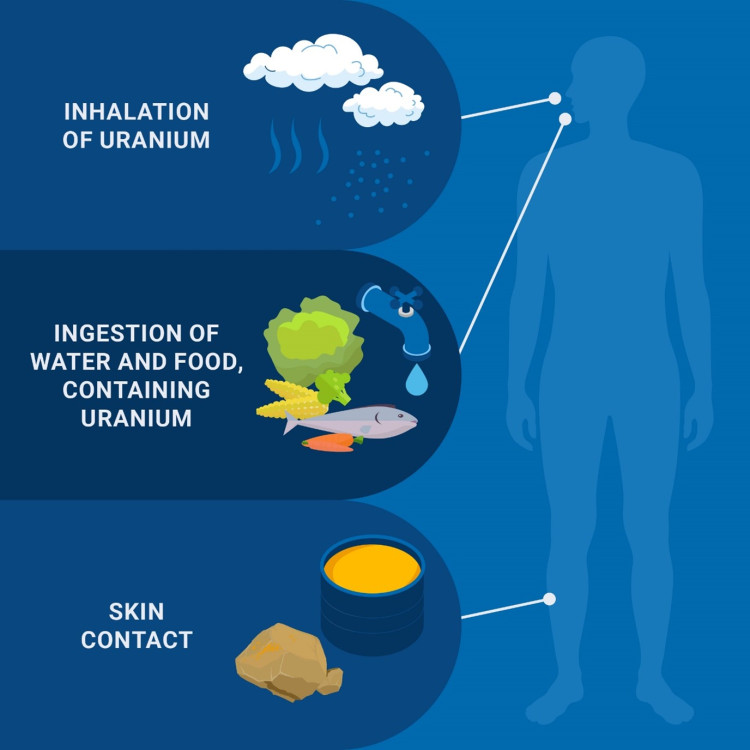
Radiation is a part of our daily lives and we are exposed to it at all times. Everyone ingests and inhales small amounts of natural uranium every day (Infographic: A. Vargas/IAEA).
Typically, the average person will receive a dose of less than 1 µSv per year from ingestion and inhalation of uranium - for comparison, a single flight from London to Los Angeles would expose you to around 58.8 µSv from cosmic radiation. In addition, an average individual will receive a dose of about 120 µSv per year from ingestion and inhalation of decay products of uranium, such as radium-226 and its progeny in water, radon-222 in homes and polonium-210 in cigarette smoke. Nevertheless, because of the differences in diets, as well as the amount of uranium in drinking water, there is a wide variation in consumption levels of uranium around the world.
Significant amounts of ingested or inhaled uranium are potentially harmful because of its chemical toxicity. People involved in the exploration, mining and processing of uranium are considered to be among the groups at risk and need to wear protective equipment, as well as to closely follow the rules and procedures to prevent health problems.
What is the role of the IAEA?
- The IAEA conducts Integrated Uranium Production Cycle Review (IUPCR) missions, which enable countries to improve their national uranium production programmes and the associated infrastructure. These missions allow to identify areas that require more focus or additional resources.
- The IAEA provides guidance documents on uranium extraction, uranium fuel fabrication and management of residues from uranium production in order to ensure that uranium is managed in a manner that is safe and secure at every step of the process.
- The IAEA hosts the International Symposium on Uranium Production and Raw Materials for the Nuclear Fuel Cycle at its Headquarters in Vienna, Austria, to discuss all aspects of uranium raw materials for the uranium fuel cycle to ensure the long term sustainability of nuclear power programmes.
- The IAEA designs the safety standards for occupational radiation protection of workers involved with the uranium mining and processing industry.
- The IAEA provides a comprehensive contemporary overview of world uranium geology and resources, allowing insight into current and potential future uranium discoveries and supply. The Agency also maintains a database of technical, geographical and geological characteristics of worldwide uranium deposits. Click here to see the map of uranium deposits around the world.
- The IAEA provides guidance on the use of techniques for analysis of undiscovered resources, including uranium.
- The IAEA's Coordination Group for Uranium Legacy Sites (CGULS) promotes cooperation among Member States with uranium legacy sites - the abandoned uranium mining sites with residues of radioactive and toxic contaminants - and fosters cooperation with national and international organizations that assist to safely remediate the sites. See this video to learn more.
- The IAEA reviews and summarizes the information about management of reprocessed uranium. It covers technical and economic issues involved in storing, handling and reusing RepU for nuclear energy generation.






